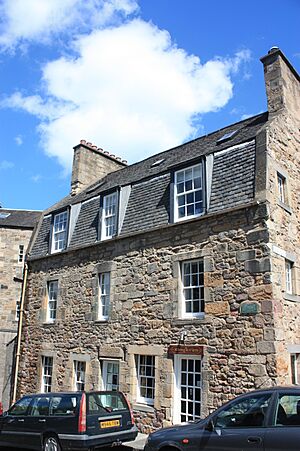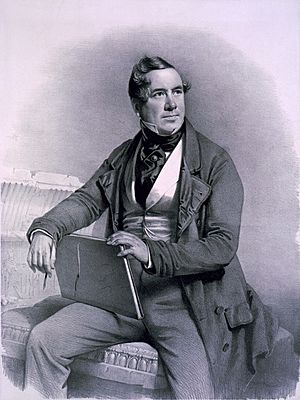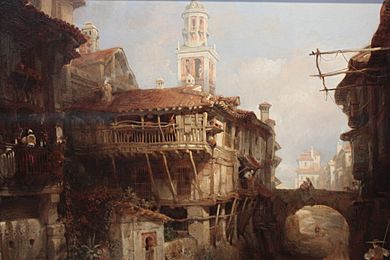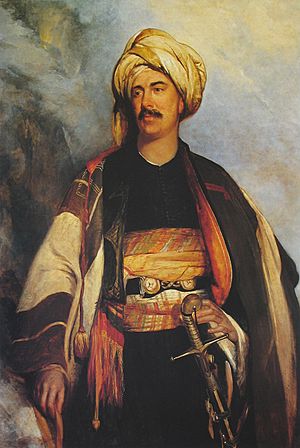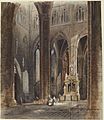David Roberts (painter) facts for kids
Quick facts for kids
David Roberts
|
|
|---|---|
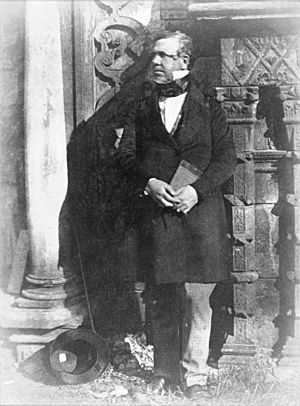
David Roberts in 1844 by Hill & Adamson
|
|
| Born | 24 October 1796 Stockbridge near Edinburgh, Scotland
|
| Died | 25 November 1864 (aged 68) London, England
|
| Nationality | Scottish |
| Movement | Orientalism |
| Elected | Royal Academician |
David Roberts (born October 24, 1796 – died November 25, 1864) was a famous Scottish painter. He is best known for his amazing pictures of Egypt and the Near East. These pictures were made into detailed prints called lithographs. He created them from sketches he drew during his long travels to these regions between 1838 and 1840. His large oil paintings of similar places also made him a well-known artist who focused on Eastern themes, a style called Orientalism. In 1841, he became a member of the Royal Academy, a very important art group.
Contents
Early Life and Art Training
David Roberts started learning about art at a young age. For seven years, he was an apprentice to a house painter and decorator named Gavin Beugo. This meant he learned how to paint and decorate buildings. During this time, he also studied art in the evenings.
After his apprenticeship, Roberts got his first paid job in 1815. He moved to Perth to help redecorate Scone Palace, a grand building.
From House Painting to Stage Scenery
In 1816, Roberts began a new path: painting scenery for the stage. He started by painting for James Bannister's circus. Bannister liked Roberts's designs so much that he hired him to travel with the circus. Roberts traveled to several English cities, painting sets for their shows. He even took on small acting roles sometimes!
After working with the circus, Roberts became an assistant stage designer at the Pantheon Theatre in Edinburgh. When that theater closed, he went back to house painting for a short time. He worked on large mansions, but he always found time to sketch in the evenings.
In 1818, Roberts returned to theater work. He became a scene painter at the Pantheon Theatre again. He often had to paint sets at night because the stage was busy during the day. His talent was noticed, and he soon became the main scene painter at the Theatre Royal in Glasgow.
Developing as a Fine Artist
In 1819, Roberts moved to the Theatre Royal in Edinburgh. Here, he met Margaret McLachlan, an actress. They married in 1820 and had a daughter named Christine in 1821.
Even though he was busy with stage painting, Roberts started to create serious oil paintings. He became friends with another artist, William Clarkson Stanfield, who also painted scenery. Stanfield encouraged Roberts's love for landscape painting. In 1821, the Fine Arts Institution in Edinburgh showed three of Roberts's paintings, and two of them sold! This was a big step for him.
Moving to London and Gaining Fame
In 1822, Roberts was offered a job in London as a scenic designer and stage painter at the Coburg Theatre (now the Old Vic). He moved there with his wife and young daughter. Later, he worked at the Theatre Royal, Drury Lane, where he created large, detailed scenes called dioramas and panoramas with Stanfield.
Roberts continued to grow as a fine artist. In 1824, he showed more of his paintings at art exhibitions. That autumn, he visited Normandy in France. His paintings from this trip helped him become more famous. One painting of Rouen Cathedral sold for a good amount of money.
Roberts also continued to be successful with his stage work. He designed sets for famous plays and operas, including Mozart's Die Entführung aus dem Serail. He also created large panoramas with Stanfield.
By 1829, Roberts was working full-time as a fine artist. He painted scenes from England, Scotland, France, and the Netherlands. In 1831, he was chosen as the president of the Society of British Artists.
Adventures in Spain and the Middle East
In 1832, David Roberts traveled to Spain and Tangiers in Morocco. He returned in 1833 with many sketches. He used these sketches to create beautiful and popular paintings. His painting Interior of Seville Cathedral sold for £300 in 1834. He also made a wonderful series of Spanish pictures for a book called the Landscape Annual in 1836.
Journey to Egypt and the Holy Land
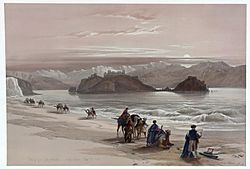
The famous artist J. M. W. Turner encouraged Roberts to stop painting for the stage and focus only on being a full-time artist. So, on August 31, 1838, Roberts set sail for Egypt. He wanted to draw pictures that he could later turn into paintings and lithographs to sell. At this time, Egypt was very popular, and people loved to buy art inspired by the East or showing ancient Egyptian monuments.
Roberts went on a long journey through Egypt, Nubia, the Sinai, the Holy Land, Jordan, and Lebanon. He created a huge collection of drawings and watercolor sketches during his travels.
In May 1839, Roberts met Muhammad Ali Pasha, the ruler of Egypt, in Alexandria. Roberts later painted this meeting from memory.
Return to Britain and Famous Works
When Roberts returned to Edinburgh in 1840, his friend and artist, Robert Scott Lauder, painted his portrait. Roberts was celebrated by Scottish society.
After coming back to Britain, Roberts worked with a lithographer named Louis Haghe from 1842 to 1849. Together, they created a magnificent series of illustrated books called The Holy Land, Syria, Idumea, Arabia, Egypt, and Nubia. These books were full of detailed prints. Roberts paid for this project by getting people to subscribe (pay in advance) for the books. He quickly got 400 subscribers, and Queen Victoria was the very first! Her complete set of books is still in the Royal Collection today. The timing was perfect, as these books were published just before photographs of these places became common.
Later Life and Legacy
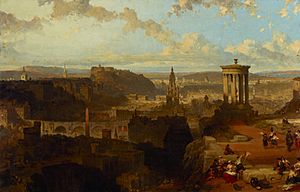
In 1851 and 1853, Roberts visited Italy. He painted famous places like the Ducal Palace in Venice and the Interior of the Basilica of St Peters in Rome.
His last book of illustrations, Italy, Classical, Historical and Picturesque, was published in 1859. He also painted a picture for Queen Victoria showing the opening of the Great Exhibition of 1851, a huge event in London.
In 1839, he became an associate of the Royal Academy, and in 1841, he became a full member. In 1858, he was given the "freedom of the city" of Edinburgh, a special honor.
In his final years, Roberts worked on a series of paintings showing views of London from the Thames River. He had finished six of these and was working on a painting of St Paul's Cathedral when he suddenly passed away on November 25, 1864. He was buried at West Norwood Cemetery.
Selected Works
Paintings
- Departure of the Israelites (1829)
- The Great Staircase, Stafford House (1832)
- Interior of Seville Cathedral (1834)
- A View in Cairo (1840)
- The Temple at Dendera (1841)
- The Gateway to the Great Temple at Baalbec (1841)
- Ruins of the Great Temple at Karnak, in Upper Egypt (1845)
- The Destruction of Jerusalem (1850)
- The Church of the Jesuits, View on the Grand Canal, Venice (1854)
- Edinburgh from the Calton Hill (1858)
- The Dogana and Santa Maria, Venice (1862)
- Street in Cairo
- Pilgrimage to Jerusalem
Prints
- Picturesque Sketches in Spain (London, 1835–36)
- The Holy Land, Syria, Idumea, Arabia, Egypt, and Nubia (London 1842–1849)
- Cities of North Africa (London 1852)
Images for kids
-
Interior of Amiens Cathedral, c. 1827. Princeton University Art Museum
See also
 In Spanish: David Roberts para niños
In Spanish: David Roberts para niños
- List of Orientalist artists
- Orientalism


